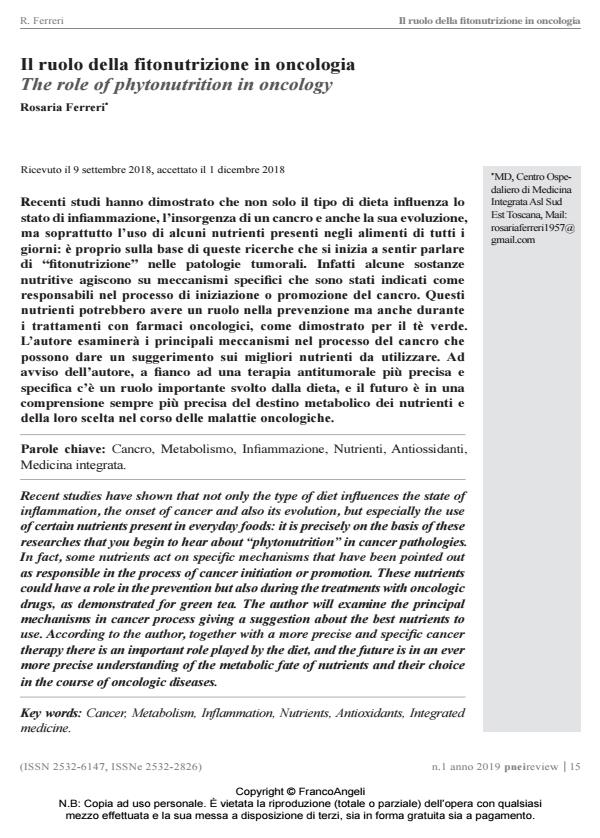Il ruolo della fitonutrizione in oncologia
Titolo Rivista PNEI REVIEW
Autori/Curatori Rosaria Ferreri
Anno di pubblicazione 2019 Fascicolo 2019/1
Lingua Italiano Numero pagine 7 P. 15-21 Dimensione file 1084 KB
DOI 10.3280/PNEI2019-001003
Il DOI è il codice a barre della proprietà intellettuale: per saperne di più
clicca qui
Qui sotto puoi vedere in anteprima la prima pagina di questo articolo.
Se questo articolo ti interessa, lo puoi acquistare (e scaricare in formato pdf) seguendo le facili indicazioni per acquistare il download credit. Acquista Download Credits per scaricare questo Articolo in formato PDF

FrancoAngeli è membro della Publishers International Linking Association, Inc (PILA)associazione indipendente e non profit per facilitare (attraverso i servizi tecnologici implementati da CrossRef.org) l’accesso degli studiosi ai contenuti digitali nelle pubblicazioni professionali e scientifiche
Recenti studi hanno dimostrato che non solo il tipo di dieta infl uenza lo stato di infi ammazione, l’insorgenza di un cancro e anche la sua evoluzione, ma soprattutto l’uso di alcuni nutrienti presenti negli alimenti di tutti i giorni: è proprio sulla base di queste ricerche che si inizia a sentir parlare di "fi tonutrizione" nelle patologie tumorali. Infatti alcune sostanze nutritive agiscono su meccanismi specifi ci che sono stati indicati come responsabili nel processo di iniziazione o promozione del cancro. Questi nutrienti potrebbero avere un ruolo nella prevenzione ma anche durante i trattamenti con farmaci oncologici, come dimostrato per il tè verde. L’autore esaminerà i principali meccanismi nel processo del cancro che possono dare un suggerimento sui migliori nutrienti da utilizzare. Ad avviso dell’autore, a fi anco ad una terapia antitumorale più precisa e specifi ca c’è un ruolo importante svolto dalla dieta, e il futuro è in una comprensione sempre più precisa del destino metabolico dei nutrienti e della loro scelta nel corso delle malattie oncologiche.
Parole chiave:Cancro, Metabolismo, Infi ammazione, Nutrienti, Antiossidanti, Medicina integrata.
Rosaria Ferreri, Il ruolo della fitonutrizione in oncologia in "PNEI REVIEW" 1/2019, pp 15-21, DOI: 10.3280/PNEI2019-001003